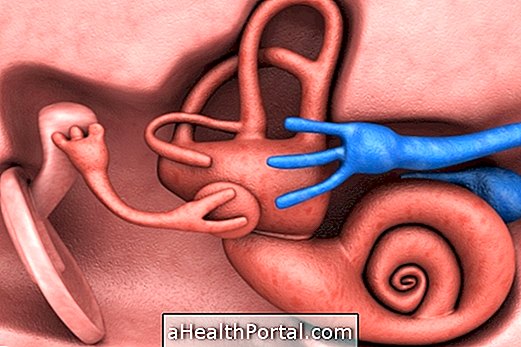Female contraceptives are drugs or medical devices used to prevent pregnancy and can be used in a pill, vaginal ring, transdermal patch, implant, injectable or intrauterine system. There are also barrier methods, such as condoms, which should be used not only to prevent pregnancy, but also to prevent the transmission of sexually transmitted diseases.
Given the wide range of women's contraceptives available and the different impact they may have on each woman, the doctor may sometimes recommend switching from one contraceptive to another, in order to find out which one fits best in each case. However, to make the exchange of contraceptive, some care must be taken, because in some cases there may be a risk of a pregnancy.
![]()
How to make the contraceptive exchange
Depending on the contraceptive you are taking and the one you are about to initiate, you should proceed in an appropriate manner for each case. Here's how to do it in each of the following situations:
1. From one combined pill to another
If the person is taking a combined contraceptive and decides to switch to another combination pill, he should preferably initiate it on the day following the administration of the last active oral contraceptive tablet used previously, and no later than the day following the interval without treatment.
If it is a combination pill that has inactive tablets, called placebo, they should not be ingested and so the new pill should be started the day after the last active tablet of the previous tablet. However, although it is not the most recommended, you can also start the new pill the day after taking the last tablet inactive.
Is there a risk of getting pregnant?
No. If you follow the previous instructions, and if the woman has used the previous method correctly, there is no risk of getting pregnant and so it is not necessary to use another contraceptive method.
2. From a transdermal patch or vaginal ring to a combined pill
If the person is using a vaginal ring or transdermal patch, the combination pill should be started, preferably on the day of removal of the ring or adhesive, but no later than the day a new ring or patch is applied .
Is there a risk of getting pregnant?
No. If you follow the previous instructions, and if the woman has used the previous method correctly, there is no risk of getting pregnant and so it is not necessary to use another contraceptive method.
![]()
3. From an injectable, implant or IUS to a combination pill
In women using an injectable contraceptive, implant, or progestogen-releasing intrauterine system, they should initiate the use of the combined oral pill on the date scheduled for the next injection or on the day of implant or IUS removal.
Is there a risk of getting pregnant?
Yes. There is a risk of getting pregnant in the first few days, so a woman should use a condom within the first 7 days of the combined oral pill.
4. From a mini-pill to a combined pill
Switching from a minipill to a combined pill can be done on any given day.
Is there a risk of getting pregnant?
Yes. When switching from a mini-pill to a combined pill, there is a risk of getting pregnant and so the woman should use a condom for the first 7 days of treatment with the new contraceptive.
5. Switching from one mini-pill to another
If the person is taking a mini-pill and decides to switch to another mini-pill, he can do so on any given day.
Is there a risk of getting pregnant?
No. If you follow the previous instructions, and if the woman has used the previous method correctly, there is no risk of getting pregnant and so it is not necessary to use another contraceptive method.
![]()
6. From a combination pill, vaginal ring or patch to a mini-pill
To switch from a combined pill to a mini-pill, the woman should take the first tablet the day after the last tablet of the combined pill. If it is a combination pill that has inactive tablets, called placebo, they should not be ingested and so the new pill should be started the day after the last active tablet of the previous tablet.
If you use a vaginal ring or transdermal patch, the woman should start the mini-pill the day after the removal of one of these contraceptives.
Is there a risk of getting pregnant?
No. If you follow the previous instructions, and if the woman has used the previous method correctly, there is no risk of getting pregnant and so it is not necessary to use another contraceptive method.
7. From an injectable, implant or IUS to a mini-pill
In women using an injectable contraceptive, implant, or progestogen-releasing intrauterine system, they should initiate the mini-pill on the date scheduled for the next injection or on the day of implant or IUS removal.
Is there a risk of getting pregnant?
Yes. When switching from an injectable, implant or IUS to a mini-pill, there is a risk of becoming pregnant and therefore the woman should use a condom for the first 7 days of treatment with the new contraceptive.
![]()
8. From a combination pill or patch to a vaginal ring
The ring should be inserted in the most tradable the day after the usual untreated interval, either from a combed pill or from a transdermal patch. If it is a combination pill that has inactive tablets, the ring should be inserted the day after the last inactive tablet is taken. Learn all about vaginal ring.
Is there a risk of getting pregnant?
No. If you follow the previous instructions, and if the woman has used the previous method correctly, there is no risk of getting pregnant and so it is not necessary to use another contraceptive method.
9. From an injectable, implant or IUS to a vaginal ring
In women using an injectable contraceptive, implant, or progestogen-releasing intrauterine system, they should insert the vaginal ring by the time of the next injection or on the day of the implant or IUS.
Is there a risk of getting pregnant?
Yes. There is a risk of getting pregnant in the first few days, so you should use a condom within the first 7 days of using the combined oral pill. Know the types of condoms and how to use them.
![]()
10. From a combination pill or vaginal ring to a transdermal patch
The patch should be placed no later than the day after the usual untreated interval, either from a combed pill or from a transdermal patch. If it is a combination pill that has inactive tablets, the ring should be inserted the day after the last inactive tablet is taken.
Is there a risk of getting pregnant?
No. If you follow the previous instructions, and if the woman has used the previous method correctly, there is no risk of getting pregnant and so it is not necessary to use another contraceptive method.
11. From an injectable, implant or IUS to a transdermal patch
In women using an injectable contraceptive, implant, or progestogen-releasing intrauterine system, they should put the patch on the date scheduled for the next injection or on the day of the implant or IUS.
Is there a risk of getting pregnant?
Yes. There is a risk of getting pregnant in the first few days, so a woman should use a condom within the first 7 days of the combined oral pill.
Watch the video below and see what to do if you forget to take the contraceptive:
![]()






















